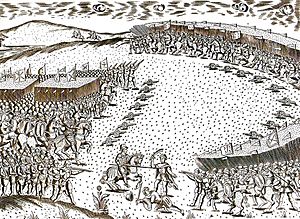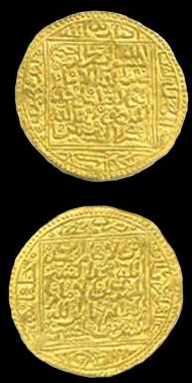Ahmad al-Mansur facts for kids
Quick facts for kids Abu al-Abbas Ahmad al-Mansurأبو العباس أحمد المنصور |
|||||||||
|---|---|---|---|---|---|---|---|---|---|
| 7th Ruler of Saadi Dynasty Amir al-Muminin |
|||||||||
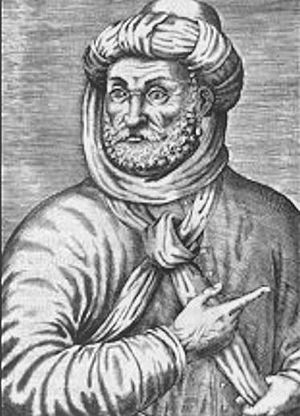 |
|||||||||
| Sultan of Morocco | |||||||||
| Reign | 1578 – 1603 | ||||||||
| Predecessor | Abd al-Malik I | ||||||||
| Successor | Civil War: Zidan al-Nasir (in Marrakesh) Abu Faris Abdallah (in Fes) |
||||||||
| Born | c. 1549 Fes Morocco Saadi Sultanate |
||||||||
| Died | 25 August 1603 (aged 53–54) Fes Morocco Saadi Sultanate |
||||||||
| Burial | August 1603 Saadian Tombs Marrakesh Morocco |
||||||||
| Spouse | Lalla Aisha bint Abu Bakkar al-Shabani | ||||||||
| Issue | Zidan al-Nasir Abu Faris Abdallah Mohammed esh-Sheikh Lalla Masouda Abdelmalik Lalla Safia Seyyidat-Elmolouk |
||||||||
|
|||||||||
| Arabic | أحمد المنصور بن محمد الشيخ بن محمد القائم بأمر الله الزيداني الحسني | ||||||||
| House | Saadi Dynasty | ||||||||
| Father | Mohammed al-Shaykh | ||||||||
| Mother | Lalla Masuda al-Wizkitiya | ||||||||
| Religion | Sunni Islam | ||||||||
| Signature |  |
||||||||
Ahmad al-Mansur (also known as Ahmad Abu al-Abbas al-Mansur or al-Mansur al-Dahabbi, meaning "the Golden") was a powerful ruler of Morocco. He was the Sultan of the Saadi dynasty from 1578 until his death in 1603. Many people consider him the most famous Saadi ruler.
Ahmad al-Mansur was an important leader in both Europe and Africa during the 1500s. He had a strong army and his country was in a key location. This made him a major player in the world during the late Renaissance period. He was also known for being very smart. He loved books, math, and learning.
Contents
Early Life and Education
Ahmad was the fifth son of Mohammed al-Shaykh, who was the first Saadi sultan of Morocco. His mother was Lalla Masuda. In 1557, his father was killed. A fight for power followed this event. Because of this, Ahmad and his brother Abd al-Malik had to leave Morocco. They stayed away for 17 years until 1576.
The brothers spent this time living among the Ottomans. They were in places like Algiers and Constantinople (modern-day Istanbul). During this time, they learned a lot from the Ottoman culture and military training. Ahmad also received a very good education. He studied many subjects, including religion, law, poetry, math, and astronomy.
Becoming Sultan
In 1578, a big battle took place called the Battle of Alcácer Quibir. Ahmad's brother, Sultan Abu Marwan Abd al-Malik I, died during this battle. The battle was against the Portuguese army.
After his brother's death, Ahmad became the new Sultan. He started his rule with great respect and wealth. This wealth came from the money paid to free the Portuguese soldiers captured in the battle.
A Golden Age of Rule (1578–1603)
Sultan al-Mansur began his rule by using his strong position. He collected a lot of money from the Portuguese to release their captured soldiers. This filled the Moroccan royal treasury. Soon after, he started building a magnificent palace in Marrakesh. It was called the El Badi Palace. This huge and beautiful palace showed Morocco's new power. He used it to welcome ambassadors and host grand parties. Building the palace started in December 1578 and finished around 1593 or 1594.
However, keeping up his large army and spy networks cost a lot of money. The palace and other building projects were also very expensive. His royal lifestyle and efforts to gain more power also drained the treasury.
Dealing with European Countries
Morocco's relationship with Christian countries was always changing. Countries like Spain and Portugal were sometimes seen as enemies. But al-Mansur knew that Morocco needed to trade and work with other European countries to be successful. To do this, Morocco needed its own large supply of gold.
Because of this, al-Mansur was very interested in the Trans-Saharan trade. This trade route brought gold from the Songhai Empire across the Sahara desert. He hoped this gold would help Morocco's economy.
Al-Mansur also became friends with England. He wanted to form an alliance with them. In 1600, he sent his secretary, Abd el-Ouahed ben Messaoud, to meet Queen Elizabeth I of England. They discussed working together against Spain.
Al-Mansur even wrote about taking back al-Andalus (parts of Spain) for Islam. He also dreamed of exploring and settling new lands in the Americas with Moroccans. He imagined Islam spreading across the oceans.
He also had French doctors at his royal court. These doctors later returned to France to teach Arabic. They also continued their diplomatic work.
Dealing with the Ottoman Empire
Al-Mansur had a complicated relationship with the Ottoman Empire. At the start of his rule, he formally recognized the Ottoman Sultan as his leader. But he still acted as an independent ruler.
However, he soon upset the Ottoman Sultan. This happened when he warmly welcomed a Spanish ambassador in 1579. The Spanish brought him many expensive gifts. He also reportedly disrespected an Ottoman symbol in 1581. He also thought the Ottomans were involved in early rebellions against him.
Because of this, he started making coins with his own name on them. He also had Friday prayers said in his name, not the Ottoman Sultan's.
The Ottoman Sultan, Murad III, began planning an attack on Morocco. When al-Mansur heard about this, he quickly sent an ambassador to Istanbul. The ambassador brought many valuable gifts. The attack was then called off. Al-Mansur agreed to pay a large amount of gold as a tribute. In return, the Ottomans left him alone.
In 1582, al-Mansur also had to agree to Ottoman "protection" over Morocco. He paid a tribute to stop attacks from Barbary pirates on Moroccan ships and coasts. In 1583, the two sultans even talked about working together against the Spanish in Oran.
After this, relations became more peaceful. Al-Mansur respected the Ottomans but also used them to his advantage. He played the Ottomans and European powers against each other. He also spread ideas that challenged the Ottoman Sultan's claim as the leader of all Muslims. He continued to send payments to Istanbul each year. Moroccans saw these as "gifts," while Ottomans saw them as "tribute."
After 1587, the power of Ottoman governors in Algiers decreased. This helped reduce tensions even more. Al-Mansur felt confident enough to stop his regular payments to Murad III. He even declared himself a caliph (a leader of all Muslims) later in his reign. He saw himself as a rival to the Ottomans, not someone below them.
Expanding the Empire
Taking Over Saharan Oases
In 1583, al-Mansur sent his army to take control of several oases in the Sahara Desert. These areas included Tuat, Jouda, Tamentit, and others. The army marched for 70 days from Marrakesh. They first asked the local leaders to obey. When the leaders refused, a war began. The Moroccan army successfully took control of these territories.
Taking Over Chinguetti
The Saadian rulers had tried to control Chinguetti before. But they only succeeded during Ahmad al-Mansur's rule. In 1584, he sent a campaign led by Muhammad bin Salem. They managed to take control of Chinguetti, which is in modern-day Mauritania.
The Songhai Campaign
The Songhai Empire was a large and powerful state in West Africa. It was one of the biggest African empires in history. In 1590, Ahmad al-Mansur took advantage of problems within the Songhai Empire. He sent an army of 4,000 men across the Sahara desert. This army was led by a Spanish general named Judar Pasha.
The Songhai army met them with 40,000 soldiers at the Battle of Tondibi. But the Moroccans had gunpowder weapons, which the Songhai did not. The Songhai army quickly fled. Ahmad's army then captured and looted important Songhai cities like Timbuktu, Djenné, and the capital, Gao.
However, it was very difficult to control such a distant territory across the Sahara. The Moroccans struggled to keep power over the conquered areas. By 1620, the Saadians had lost control of these cities.
Legacy and Impact
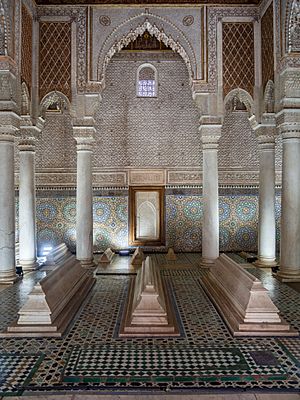
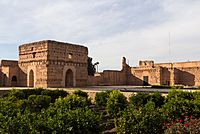
Ahmad al-Mansur died in 1603. He was buried in the beautiful Saadian Tombs in Marrakesh. After his death, his sons Zidan al-Nasir and Abou Fares Abdallah fought for power. This led to a civil war.
Al-Mansur was very skilled in diplomacy. He managed to keep Morocco independent by resisting the demands of the Ottoman Sultan. He was good at balancing power by playing European countries and the Ottomans against each other.
However, he spent much more money than he collected. He tried to expand his empire through conquests. While his army was successful in the beginning against the Songhai Empire, it became harder to control those distant lands over time. As Morocco struggled in Songhai, its power and reputation in the world decreased.
Ahmad al-Mansur was also one of the first rulers to take action against smoking. In 1602, he used religious rulings called fatwas to discourage people from using tobacco.
Popular Culture
- Ahmad al-Mansur is a playable leader for the Moroccan civilization in the 2013 computer game Civilization V: Brave New World.
Images for kids
-
The Kasbah of Marrakesh, including the El Badi Palace, by Adriaen Matham, 1640.
-
In 1600 Ahmad al-Mansur sent his Secretary Abd el-Ouahed ben Messaoud (pictured) as ambassador of Morocco to the court of Queen Elizabeth I of England to negotiate an alliance against Spain.
See also
 In Spanish: Ahmad al-Mansur para niños
In Spanish: Ahmad al-Mansur para niños


